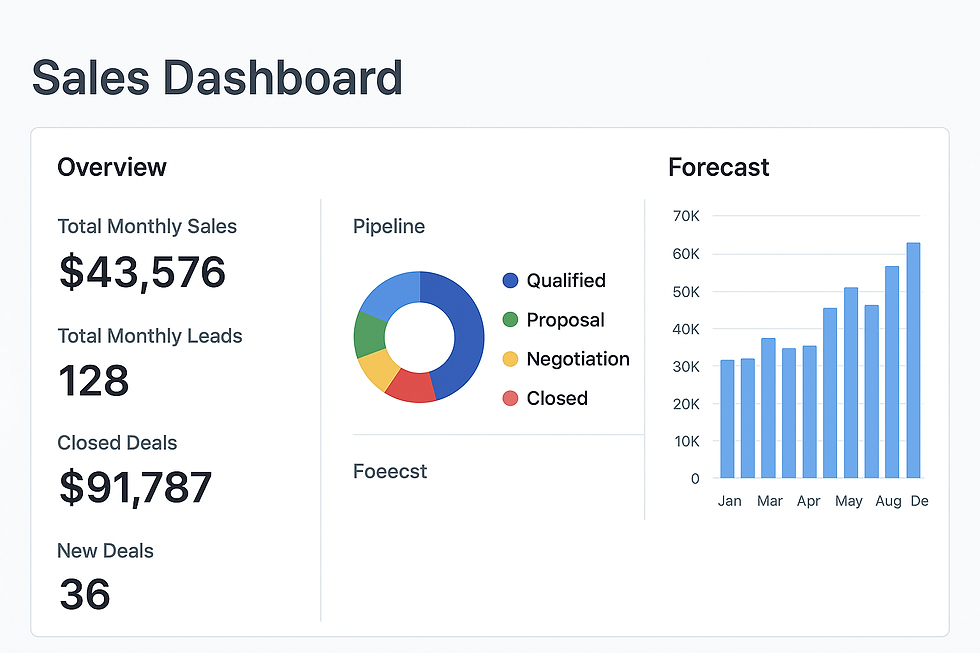How to Make the Transition from the "Art of the Sale" to the "Science of Selling"
- ClickInsights

- Aug 21
- 4 min read
I. Introduction: The World of Sales is Evolving
Sales was once an art form rooted in charm, intuition, and charisma. A good salesperson could enter a room, feel out the atmosphere, and close the deal simply on personality and charm alone.
But not anymore in today's competitive marketplace.
Consumers are better informed than ever. The sales cycles are more complicated and competitive. And those firms relying only on the "art" of the sale are too often subjected to inconsistent outcomes and lost opportunities.
The future is with those sales groups that bring together the human element with a scientific, data-driven methodology. This fusion produces a sales engine that is predictable, scalable, and significantly more apt to succeed in today's rapidly changing market.
II. The Classic "Art of the Sale"
In sales, the “art” lies in the intuition: forming relationships, crafting stories, and conversing with instinct.
It used to work wonderfully. Buyers didn't have much information; there were fewer competitors vying for attention, and sales relationships lasted for years.
The strengths of the classic approach:
Creates strong trust with customers
Fits uniquely to buyer personalities
Facilitates creative problem-solving
In today’s environment, however, this strategy shows its limits. It causes inconsistent performance, is hard to reproduce in a whole sales team, and is practically impossible to scale up properly.

III. The Emergence of the "Science of Selling"
The science of selling applies data, analytics, technology, and processable processes to enhance win rates and accuracy in forecasting.
Several drivers have fueled this transition:
The explosion of CRM system sales data, engagement analytics, and buying signals
Artificial intelligence and automation tools that optimise outreach
Competitive pressure to produce predictable, measurable outcomes
Advantages of the scientific method:
Sets precise benchmarks and KPIs.
Unmasks winning behaviours that can be coached and emulated.
Minimises reliance on individual "superstar" reps, which makes performance more consistent across the team.

IV. Balancing Art and Science
You can embrace sales science without letting go of its artistry. The human touch remains paramount, particularly for developing trust, empathy, and landing intricate deals.
How science augments the art:
You can master the science of selling while keeping its artistry alive.
Standardized processes ensure best practices are uniformly implemented.
Once the conversation begins, a salesperson’s storytelling talent and active listening become the deciding factors.
Example: A rep could use intent data to identify a prospect investigating an issue their product resolves. Data indicates when to call, but art helps them build rapport and seal the sale.
V. Steps to Make the Shift
Moving from selling as an art to blending art with science demands both strategy and persistence. Follow these step-by-step steps:
Audit Your Sales Process
Plot out every step of your sales cycle and where decisions are being made on gut instinct. These are areas where data might inform improved behaviour. For instance, if your sales staff bases follow-up on "gut feeling," substitute it with follow-up timing data from your CRM.
Implement the Right Tools
Equip your team with cutting-edge CRM systems, analytics dashboards, sales engagement tools, and AI-powered forecasting. These products consolidate information, surface opportunities, and improve decision-making.
Train for Data Literacy
Data only matters if your team can leverage it. Spend in training that enables sales reps to read trends, comprehend lead scoring, and relate data insights to sales action.
Create Playbooks
Write winning strategies down so they can be replicated throughout the team. They should incorporate scripts, email templates, objection techniques, and timing rules based on results that work.
Make Room for Art in Each Step
Even in a data-driven process, creativity should have a seat at the table. Make reps flexible with scripts for varying personalities, utilize customized stories, and listen attentively on calls.
Track and Iterate
The market is constantly changing, your process should be too. Check performance metrics every month, test A/B on sales tactics, and optimize playbooks from what has proven to work.
VI. Overcoming Resistance to Change
Part of your sales team may fear that the addition of more science to selling will turn the process mechanical or take the human element away. The truth is the opposite: data eliminates guessing so that reps can concentrate on establishing real relationships.
How to address resistance
Give early wins from your team to demonstrate that the model is a success.
Make clear that data is a means to empower, rather than to replace human talent.
Urge leaders to lead by example by making decisions on their own based on data.
VII. Conclusion: A Future-Proof Sales Team
The best sales teams today know how to unite sales science with sales artistry. The art contributes empathy, storytelling, and flexibility. The science offers precision, predictability, and scalability.
Data-driven selling doesn't remove humanity. It makes the human factor more effective by making the sales reps direct their energy towards the right prospects, at the right moment, with the right message.
Once this shift happens, your team will be positioned to:
Boost win rates with improved targeting.
Tighten sales cycles with superior timing.
Scale best practices to every rep, not only the superstars
The transition from art to science is not optional in today's hyper-competitive market. Those who embrace it will set the standard for modern selling, while those who resist will fall behind. The opportunity is clear: combine the best of both worlds, and you will not just meet your sales targets. you will consistently exceed them.



Comments